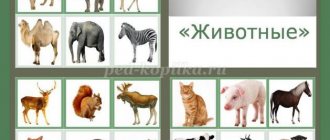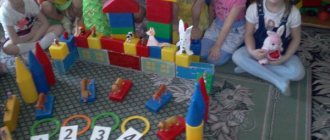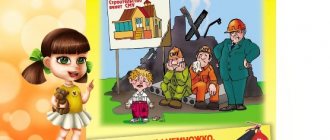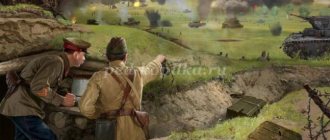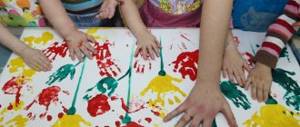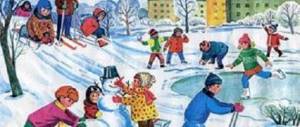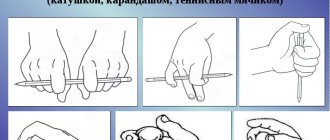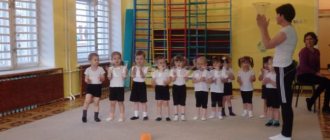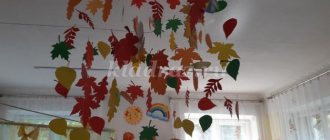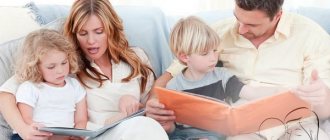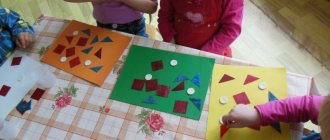Standards and recommendations of the Federal State Educational Standard for the organization of educational activities
To implement direct educational activities, the Federal State Educational Standard dictates several recommendations and standards. The regulatory legal framework should include the following documents:
- UN Convention on the Rights of the Child;
- Constitution of the Russian Federation;
- Sanitary and epidemiological requirements for a preschool institution;
- Federal Law “On Education”;
- Federal state educational standard for preschool education.
Preschoolers receive new information about the world around them
On the basis of these documents, all work programs and plans are drawn up, as well as the entire content of educational activities.
Among the recommendations are the stages of implementation of the GCD:
- Motivational stage (creating interest and motivation).
- Content stage (individual or group training and education).
- The final stage (reflection).
For a successful educational process, the Federal State Educational Standard specifies the principles of organizing educational activities (health conservation, personal-oriented and developmental education, interest, and others). As well as SanPiN requirements, thematic, didactic and organizational requirements.
Note! Organizational requirements include structure, time and duration, as well as conditions and material and technical equipment for conducting classes.
Lesson structure
A lesson on familiarization with the outside world in the second junior group is held once every two weeks. One lesson includes several steps:
- Introductory part, motivation. Duration 1-2 minutes. This part uses educational riddles, short poems, questions and fairy tales. Also, the teacher in this part must establish contact with the group so that all children are included in cognitive activities.
- Main part. Lasts about 10-12 minutes. At this stage, children learn new things, reproduce and consolidate the information received.
- Final part. Duration about 1.5 minutes. Reflection is carried out, results are summed up.
Important! For the younger age group, it is necessary to select forms of work that correspond to the age characteristics of the children. This should be a changing activity, the absence of numerous questions, the presence of didactic and visual material.
Availability of didactic and visual material
Temporary standards for conducting classes
In the second youngest group, children do not yet know how to focus on the material offered for a long time. According to age standards, one lesson should be no more than 15 minutes. The weekly load is 11 sessions, that is, one or two short exercises per day. Classes with increased intellectual activity should be carried out in the first half of the day and on days of highest cognitive activity. It is also recommended to conduct physical exercises or musical breaks in the middle of the lesson, which makes development gentle and prevents overwork.
Analysis and diagnosis of cognitive and research activities of children aged 1.5–4 years
Children aged 1.5-4 years are characterized by the desire to personally verify the veracity of statements. Only in practice can you find out that in the event of an impact, an object breaks, that water spreads, and soap is tasteless, although it smells good.
Involuntary attention and memory are another feature. In practice, this means that the child will not be able to concentrate and remember the adult’s instructions by ear. Therefore, for the lesson to take place, it is necessary to constantly return the child’s attention to the subject of conversation.
Important! Everything that happens should be fun, interactive and attention-grabbing. At any time during the lesson, the child must be ready to engage in practical activities. Although involuntary memory complicates the teacher’s task, it allows one to retain experienced emotions well in memory.
In classes that are devoted to the practical research activities of children, you can raise any topic. Moreover, they are perfect for integration into other areas of learning (speech, reading, fine art, arithmetic). The main thing that a teacher should think about is how to give the child the opportunity to participate in practical activities. Research should not be limited to kindergarten. It's good if parents continue homeschooling.
Summary of an approximate lesson on familiarization with the outside world in junior groups of preschool educational institutions
Lesson on the topic “Family”
Goal: to form ideas about the family, to cultivate interest in names.
Additional material: family photo, glue and disposable plates according to the number of children in the group.
Methods for diagnosing and developing memory in preschool children
Motivational part: Riddles about family, or a conversation about who is part of the children’s family (mom, dad, brother, sister, grandmothers, and others). The teacher involves all children in the lesson with leading questions. It is important to give each child a say or set up a small stand with photographs that the children from the group can see.
Content: Instead of a teacher, a fairy-tale character can ask questions: a soft toy or a doll. A problematic situation is posed, or a story is read that the character’s entire family has gathered at a large table for dinner and only one seat is left unoccupied. The question is asked why a family member is absent, who may be absent, for what reasons. Next, move on to the children's families. A conversation about what a family is and what traditions, besides evening dinner, the family has.
; Note! In this part of the lesson, you can use finger exercises (how mom cooked porridge, how dad worked, how grandma knitted, how brother rolled the car, and so on). Finger gymnastics can be diluted with general physical exercises and thus replace physical exercise.
During the lesson, talk to the children about the feelings that other family members experience when someone is not at home. A conclusion is required. In a fairy-tale character, someone must return to an empty place in order to clearly show the entire composition of the family.
Reflection: After the story, you can create a photo frame. Children glue the photo onto a plate and can put the frame in a visible place at home and share their impressions of the lesson. At the end, the children talk about their feelings and answer questions about what they remember, what a family is, what emotions they experienced when the character was missing one of the family members, how joyful the day was when the whole family was gathered.
Cognitive and research activities of children in junior groups 1 and 2
Such activities of children in junior groups 1 and 2 consist of various stages.
Types and stages of cognitive activity
The stages of cognitive activity have the following structure:
- Formulation of the problem when the teacher is engaged in setting the main goal.
- Studying information - children can make assumptions about the topic at hand, explain on their own why it happens this way and not otherwise.
- Formulation of a practical solution - the teacher suggests steps to study the problem.
- Collecting materials - children and the teacher together prepare the things that will be needed for the practical experiment.
- When conducting an experiment, it is imperative to involve all children in the group.
- Analysis and formulation of conclusions.
Note! In this case, types of cognitive activity can be either spontaneous or organized. Spontaneous activity begins if the child is suddenly interested in something. Organized - in case of proper motivation and under the control of the teacher.
Materials for educational activities
Motivation and task of classes
Cognitive development in the younger group takes place under the motto: “The child acquires knowledge.” That is, any activity that at first glance seems like pampering can turn out to be a process of learning (if you break a toy, you study its structure).
Important! The teacher’s task is to organize situations that can arouse interest in the group and surprise them with novelty. So the first months in the younger groups are associated with exploring the premises and new people. But soon everything is learned, and the child begins to get bored. The teacher’s task is to prevent such stagnation.
The task of cognitive-research activity is to give scope for visual-effective thinking, which is typical for children in the younger group. In addition, it is important to provide the opportunity to experience practical experience. All this will form in the character a constant desire to explore the world around us, a love of knowledge and curiosity.
To motivate a child to study according to the algorithm proposed by the teacher, you can use the following levers:
- Game motivation - during the game a problem arises, and children must solve it. For example, the situation: “Help the toy find its home.”
- Helping an adult - younger people like to help older people and communicate with them as equals. Children show interest in joint activities.
- “Teach me” - an adult asks a child to teach him something or explain a topic.
- Crafting – Children will enjoy making crafts for their own use.
Card index and goals of reading fiction in younger groups
It is worth remembering the rules of motivation:
- You can’t impose a vision of the game on younger people;
- the child’s opinion must be taken into account; he has the right not to want to do something;
- You should be praised for the results obtained.
Important ! You cannot resort to the “Helping Adults” motivation, completely shifting the work onto the child and leaving him to cope with the task alone. An adult and a child are a team that works together, actively communicating.
Methodical techniques of the teacher
During classes to get acquainted with the outside world in the 2nd junior group, the following techniques are used:
- Verbal (story, conversation, dialogues, reading).
- Demonstration (display of illustrations, videos, presentations, study of natural objects and herbariums, excursions).
- Practical (experiments, games, performing any actions with objects and materials).
Work to familiarize yourself with the outside world
The game occupies a priority place in the teaching methods. It is through play that a child gains emotional experience and remembers faster. Story-based games based on fairy tales, farm and zoo games with domestic and wild animals, and learning the seasons with dolls give the child the opportunity not only to learn new things, but also to consolidate the acquired knowledge.
For example, by offering your child the game “Who Eats What,” you can get acquainted with wild and domestic animals, study forest animals, insects and birds, find out what edible and inedible plants and mushrooms are, and determine which plants grow fruits to feed different animals.
Step-by-step drawing for beginners - lessons for children
Games can be plot-role-playing, motor, creative, labor and didactic games of a natural history nature. Each activity can turn into a small journey and give your child the pleasure of learning new things.
Note! All classes in kindergarten are conducted in accordance with the requirements of the Federal State Educational Standard.
Abstract of educational activities for cognitive development in the second junior group “We have a vegetable garden”
Bibliographic description:
Khaichenko, V.N. Abstract of educational activities on cognitive development in the second junior group “We have a vegetable garden” / V.N. Khaichenko, G.G. Nechepaeva. — Text: immediate // Theory and practice of education in the modern world: materials of the IX International. scientific conf. (St. Petersburg, July 2020). - St. Petersburg: Own publishing house, 2020. - pp. 30-31. — URL: https://moluch.ru/conf/ped/archive/192/10746/ (access date: 10.10.2020).
Program content:
- To form children's understanding of vegetables: where they grow, how to care for them.
- Teach children to recognize and name carrots and cabbage by appearance, and to identify the characteristic features of vegetables. 3. Consolidate knowledge about the place where vegetables grow. 4. Develop the ability to solve riddles. 5. Enrich active vocabulary: vegetable garden, garden bed, vegetables. 6. Cultivate a desire to work and help others.
Preliminary work: Excursion to the garden, conversation, looking at illustrations, observation, didactic games, role-playing games. Material: Toy - Hare, carrots, cabbage, “beds” with vegetables (dummies), use of ICT, basket with vegetables, 2 cars, illustrations depicting vegetables.
Types of children's activities: gaming, communicative, cognitive and research, perception of fiction and folklore, musical, motor.
The course of children's organized activities.
The teacher invites the kids to play in the group. The children enter and then they see that the Bunny is sitting on a chair in the playroom with a basket and sighs sadly. Educator: Children, look who came to visit us?
Children: Bunny came to visit us.
Educator: Guys, say hello to Bunny. The children greet Bunny and invite him to play with them. The bunny refuses to play with the children; he has a lot to do. Educator: Bunny, what are you doing? The bunny replies that it is already cold outside, and his vegetable beds have not been harvested. Educator: Bunny, don’t worry, the guys will help you harvest. Bunny: Guys, do you like to work? Can you help me harvest from the garden beds?
(Children's answers: they love to work and will be very happy to help Bunny). The teacher invites the children to show Bunny what vegetables they collected from the garden beds and tell him how they looked after their garden. The teacher brings a basket of vegetables and asks the children to name the vegetables that are in the basket.
(Children name vegetables, individual answers)
Educator: Children, where do vegetables grow? Children: In the garden in the beds. (children’s individual answers)
Educator: Guys, how did you take care of them?
Children: Watered the vegetables, pulled out the weeds. Educator: Guys, I suggest you guess riddles about vegetables, listen carefully and guess.
- What's that squeak? What's that crunch? What kind of bush is this? How can I be without crunch, If I... Children (cabbage)
Educator: That's right, children, this is cabbage. Let's look at it. Children look at a head of cabbage, name its shape and the color of the leaves. The teacher invites the children to guess another riddle.
- in the ground so cleverly, Only her tail is visible, How insulting we are... Children (carrots) Educator: What color is it? (children's answers) Which carrot is big or small? (Children's answers) Educator: Well done, children, you solved all the riddles, and now you want to play with Bunny?
Children: Yes, we want.
Game "Vegetable Garden"
- garden is in order, we dug up the beds in the spring, (imitation of working with a shovel) We weeded the garden, (bend over, reach the floor with your hands) Watered the garden (show how they watered) in the small holes, we planted cabbage . (Squat down, clasp your knees with your hands) All summer she grew fat, grew in breadth and height, (rise up slowly) And now she is cramped, poor, says: “Move aside!” (stomp your foot)
Educator: Bunny, did you like playing with the guys? Bunny: Yes, I liked it. Educator: Children, together with Bunny, let's see how we looked after our beds and collected vegetables.
Slide show “Our garden” 1st slide (Children in the garden) Educator: Children, tell Bunny where you were and what you saw? The children answer that they were in the garden and saw a lot of vegetables there. Educator: name the vegetables you see? Children: cabbage, carrots... 2nd slide (Children water cabbage, carrots) Educator: Guys, tell me what Masha and Artyom are doing? Children's answers: Masha and Artyom are watering the cabbage. 3rd slide (Children collected cabbage and carrots in baskets) Educator: Guys, name the vegetables that you collected in baskets? Children: Cabbage, carrots. Educator: How can you call this, in one word? Children: Vegetables. The bunny praises the children, the kids love to work, and invites them to help him collect the harvest. The children go with the teacher to the Bunny's garden.
- to the garden and collect the harvest!
(Children follow the teacher, raising their knees high)
Hey, horse, gop-gop, take us to the garden.
Hey horse, hush, hush. The garden is getting closer and closer.
Now there's a vegetable garden! everything grows in Children approach the “beds” on which vegetables (dummies) “grow.” Educator: Guys, we came to Bunny’s garden. Look at Bunny's two beds. What is growing in this garden bed? Children: Cabbage. Educator: What is growing in this garden bed? Children: Carrot. The teacher invites the children to help the Bunny collect the harvest. Children collect cabbage and carrots, put them in trucks and take them to the group. Bunny thanks the guys for their help, they helped him a lot.
The teacher invites the children to a table on which cards with pictures of vegetables are laid out and invites the children to select cards with pictures of carrots and cabbage and give them to Bunny.
(Children find pictures with vegetables and give them to Bunny)
Bunny: Guys, thank you, you gave me a good mood.
Educator: Children, where were you today?
Children: In the garden.
Educator: What grows in the garden?
Children: carrots, cabbage.
Educator: Where do carrots and cabbage grow?
Children: In the garden beds. (Individual answers)
Educator: Children, I’ll take the vegetables to the kitchen, and the cook will prepare us a delicious salad, and invite Bunny for a walk and play with you.
Children invite Bunny for a walk.
Key terms
(automatically generated)
: child, teacher, Bunny, vegetable, cabbage, vegetable garden, garden bed, children's answer, Guys, image of vegetables.
